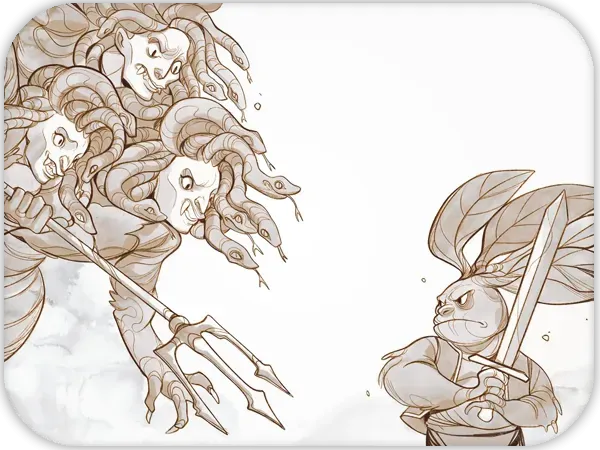Anne -
Firecurl
The girl who fell into an incomprehensible
and threatening world – and stayed
long enough to change it.

Anne Ravenhead, whom everybody calls Firecurl is not just the protagonist – she is the question the story asks.
She enters the Forest like a whirlwind: impatient, curious, and full of herself. Nothing is explained to her, and yet she barrels forward, pushing buttons, shouting at birds, opening doors meant to stay shut. At first, she fails again and again – but never in the same way twice.
Her real strength is not magic or strength of will. It’s her creativity. When rules don’t work, she rewrites them. When paths are blocked, she invents new ones. And when she’s stuck, she listens – often to those she least expected to need.
Anne’s role in the story is to stumble into problems no one else can solve, and solve them in ways no one else would have tried. She builds teams out of chaos, finds hope in ruins, and keeps going – not because she knows the way, but because she can’t help but try.
She doesn’t set out to be a hero. In fact, most of the time, she doesn’t even realize she’s leading anyone. Her courage is clumsy, her instincts imperfect—but her heart is wide open. What makes Anne compelling isn’t certainty, but movement. She changes because she’s willing to be wrong, to be hurt, to look foolish. And in a world where everything is uncertain, that kind of honesty becomes its own kind of power.
– Red hair = the fire of change
– Backpack = her conscience
– Shoes = her broken promise
– Mirror = her evolving self-perception
My new doll has lice. I had to do something.
If you won’t want peace — here’s an axe for you!
I really want us to be friends. The real kind!
Oh, if only I were as strong as Pippi Longstocking!
Yes. That really was something magical.
📘 Book I
In the first book, Anne begins as an arrogant and careless child. Her clash with the Ghost Forest breaks her down and forces her to grow up.
– Arrogant, spoiled, lonely.
– Her cruelty is unintentional: she breaks her toys without understanding the consequences.
– She is forced to pass through a moral labyrinth, confronting guilt, fear, and failure.
– Her transformation begins through friendship (Pouchy), humility (Grandpa Hedgehog), and courage.
– In the finale: an act of self-sacrifice that elevates her to the rank of a moral hero.
📗 Book II
In the second book, she is accused of imaginary crimes — and must fight not only for herself, but for the truth. In the third book, she has matured and become a leader, someone others are willing to follow… when she isn’t being overtaken by a stray whim, of course.
– She returns to discover that her story has been misused — Heino has turned everything upside down and used his media power to make all the forest dwellers see it as undeniable truth.
– Now cast as the villain, she must find her way in a world built on lies about her.
– She becomes more strategic and critical.
– She learns to recognize manipulation not only in villains, but also within herself.
– She begins to understand the system she’s caught in — and how memory can be weaponized.
📙 Book III
– The trauma resurfaces: the ghosts are still lost, and new ones stalk the Desert.
– Anne becomes the only character whose memory remains intact.
– Her journey is one of witness and protector — not of warrior.
– She must face the truth about Laptsev, the Fire, and herself.
– She finds redemption not through battle, but by telling the forgotten truth.
Is she really the mysterious savior spoken of in the Forest’s ancient prophecy?
Will she ever find the end of the Forest?
Why did Nerod Laptsev choose her, of all people, as the focus of his magical attention?




